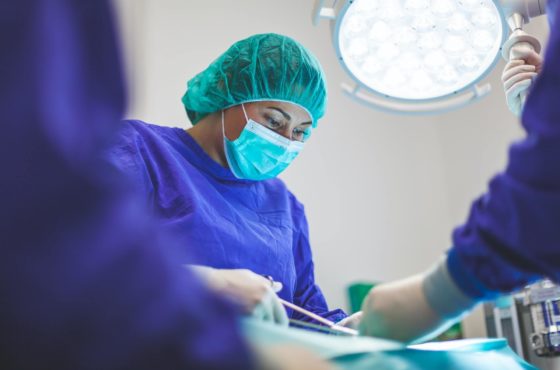Hernias are an extremely common health problem. Anyone can develop this medical condition, including men, women, and children.
A hernia occurs when a tissue or organ pushes through a weak place in the surrounding tissue or wall of muscle and fiber that usually contains them.
Each year, more than one million hernia repairs are performed in the United States alone. The hernia mesh or surgical mesh has been widely used by surgeons for the last few decades to treat the majority of hernias.
Lately, however, more and more questions have been emerging about the safety of the surgical mesh.
Hernia Repair
Hernias can be caused by anything that puts increased pressure on the abdomen. This can include obesity, lifting heavy objects, diarrhea, constipation, or constant coughing or sneezing.
Hernias may also be caused by weak muscles. In most cases, occurrence of a hernia can be caused by a combination of weak muscles and increased pressure.
One common but major surgery used to treat hernia is a hernia repair.
A hernia repair is the surgical procedure done to fix hernia. It is also called as herniorrhaphy. A hernia repair returns the organ to its appropriate place and fixes the weakened area of tissue.
However, hernia repairs can also come with significant risks and a myriad of complications.
There are many different types of hernias, depending on the part of the body that’s affected. But some of the most common ones are the inguinal hernia, umbilical hernia, and hiatal hernia.
Inguinal hernia is possibly the most common type of hernia. Inguinal hernias occur when a tissue, such as a part of the intestine, protrudes through a weak spot in the abdominal muscles.
On the other hand, an umbilical hernia is an abnormal bulge that can be seen or felt near or at your belly button.
Lastly, hiatal hernias form when your stomach bulges through an opening in your diaphragm called the hiatus.
What Exactly is a Surgical Mesh?
According to the U.S. Food and Drug Administration, the surgical mesh is a medical device that is used to provide additional support to weakened or damaged tissue.
Hernia mesh products come in different shapes and sizes, although the majority of these medical devices available for use are from synthetic materials or cow or pig tissue.
Hernia mesh made of synthetic materials can be found in knitted mesh or non-knitted sheets. These synthetic materials can either be absorbable, non-absorbable, or a combination of both.
Mesh made of animal tissue are absorbable. This absorbable mesh is meant to degrade over time and therefore is not intended to provide long-term repair for hernias.
On the other hand, the non-absorbable type of synthetic surgical mesh is covered in a protective substance since this mesh is designed to remain in one’s body indefinitely and is considered a permanent implant.
Both types of synthetic hernia mesh have been linked to a number of safety issues regarding the medical device.
Is the Mesh Used for Hernia Repair Surgery Safe?
The U.S. FDA considers hernia mesh safe.
In most cases, the use of hernia mesh is the acceptable standard of care. However, complications related to the mesh can certainly arise.
In fact, according to a 2016 study, “nearly a third of patients experienced complications or needed additional surgery more than five years after the surgical mesh was implanted.”
And these complications can be found in recently filed complaints the hernia mesh lawsuits.
You read that right. The hernia mesh actually has a couple of lawsuits under its name.
The good news?
An increasing number of people are now fighting for their rights and joining the legal battle by filing a complaint, as they, too, have experienced grievous injuries and complications following a hernia repair surgery.
Every year, more than 100,000 hernia mesh devices are implanted in the U.S. alone. It has only been recently when a fraction of the medical device implants were recalled because of various medical reasons.
Why Do Surgeons Use the Mesh for Hernia Repairs?
Several years ago, hernia repairs were performed by simply suturing the hernia close.
For some types of hernias, this procedure resulted in around 25-50% of hernias later coming back in patients.
The surgical mesh changed that.
The main reason surgeons perform hernia repair with mesh is to lower the chance of a hernia coming back, a condition also known as hernia recurrence.
The truth?
There is actually a high chance of hernias returning after a hernia repair surgery.
Traditional hernia repair stitches torn tissue back together. A number of studies have shown that surgeries which made use of the mesh led to fewer cases of hernia recurrence.
Meanwhile, other studies have also found that there are other complications which are more commonly encountered with the use of surgical mesh.
Hernia Mesh Manufacturer Recalls
The first hernia mesh recall was issued in late 2005 by Davol Inc., a subsidiary of C.R. Bard.
Moreover, in 2014, the FDA announced a number of hernia mesh recalls and started to warn patients and the public about the medical device.
The recalled products were pulled from the market because of reasons ranging from packaging errors to poor performance to adverse reactions.
Some of the companies targeted by the regulating agency were C.R. Bard for the potential risk of the defective mesh ring breaking apart and causing bowel obstruction or perforations, Ethicon Inc. for the potential hazard of the mesh losing its laminate coating, and Atrium Medical Corporation for packaging errors.
Complications and Risks from Recalled Mesh Products
The U.S. FDA keeps a record of complications related to the hernia mesh.
One way to alert the regulator of these injuries is to file a hernia mesh lawsuit against the manufacturer of the allegedly defective medical device.
Once a claim is filed against a company, the manufacturer is required to report the lawsuit to the FDA.
Generally, the more lawsuits filed, the more likely it is that the FDA will take a second or third look at a certain device and the adverse effects surrounding it.
The most common complications following a hernia surgery repair include:
- pain
- infection
- adhesion
- hernia recurrence
- bowel obstruction
- organ perforation
- rejection
- chronic pain and discomfort
All of these may need additional surgery to correct.
According to the FDA, most of the complaints that have been reported to the agency are in connection to the mesh products which were already recalled.
Other reports have also detailed the mesh shrinking or migrating inside the body after hernia surgery.
How Many Years Does Hernia Repair Last?
Studies have conflicting results on how long a hernia repair will last.
Hernia recurrence used to be the most common complication before the invention of the hernia mesh.
A 2014 study in JAMA Surgery looked at around 190,000 hernia repairs. Researchers found that hernia recurrence was only present in only 2.7 percent of hernia repairs, as compared to 8.2 percent of repairs using stitches alone.
However, a 2016 study in JAMA had different findings.
In this study, researchers looked at 3,242 patients. They were able to find that a number of hernia mesh problems increased in the first five years following a hernia repair surgery.
What are the Symptoms of Hernia Mesh Failure?
You can tell that your surgical mesh has failed once you begin to experience symptoms immediately or even years after hernia surgery.
Below is a list of hernia mesh failure symptoms you should watch out for:
- high fever
- severe pain
- nausea and vomiting
- bruising and swelling
- difficulty urinating and passing gas and stool
- inflammation around the surgical site
If you happen to notice these symptoms, you should talk to your doctor as soon as possible.
Hernia mesh failure symptoms are difficult to diagnose alone. You should tell your doctor that you are having these symptoms and that you have a hernia mesh implant.
Are there Medical Alternatives to Hernia Mesh?
The short answer? Yes.
There are some medical alternatives to the surgical mesh. They are all surgical procedures and they all involve stitching the affected or damaged tissue back together.
Some mesh surgeries that do not use mesh are the Bassini repair, Desarda repair, and the Shouldice repair.
The Shouldice repair is a type of treatment mostly used in dealing with inguinal hernias. The procedure involves using the patient’s own tissue to repair the hernia. It requires a sedative and a local anesthesia.
Since no foreign products are implanted into the patient’s body during surgery, it eliminates the chances of bowel obstruction, fistula, bowel perforation, or adhesion.
In some cases, doctors may advise “watchful waiting” before a hernia surgery.
This is when doctors closely watch a patient’s condition but not giving treatment unless symptoms appear or change, until it requires surgery.



